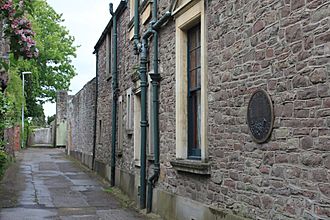The Mynde (Caerleon) facts for kids
Quick facts for kids The Mynde |
|
|---|---|

The town walls that guard the Mynde
|
|
| General information | |
| Architectural style | Modern (house) Regency era walls Roman and Medieval (foundations) |
| Town or city | Caerleon, Newport |
| Country | Wales |
| Coordinates | 51°36′34″N 2°57′06″W / 51.609445°N 2.951748°W |
| Completed | 1067–1075 (castle) 1839 (walls) |
| Renovated | 1928, 1938, 1978 |
| Technical details | |
| Size | 8,100 sq ft house 3.5 acres land |
The Mynde (which means Y Mynde in Welsh) is a very old and important place in Caerleon, a town near Newport. Caerleon is famous for being the home of a huge Roman army base called Isca Augusta long ago. The Mynde has a rich history, from Roman times to today.
Contents
Exploring The Mynde's History
Roman Times in Caerleon
Caerleon became a busy place around 75 AD when the Roman army arrived. They built a large fortress and port here. You can still see many well-preserved Roman sites in Caerleon. These include the Caerleon Amphitheatre, military bath houses, and parts of the fortress wall. This wall stands about 12 feet (3.7 meters) tall.
Some stories even connect Caerleon to the legendary King Arthur. An old book from 830 AD, called Historia Brittonum, mentions 'The City Of The Legion'. Many people believe this city was Caerleon. Later, between 1067 and 1075, a castle was built on this site. This happened during the time when the Anglo-Normans were moving west from Chepstow.
The Mynde in the 1800s
For many years, the land around The Mynde had old Roman and medieval stone ruins. In the 1800s, these stones were moved, and soil was added to build the walls we see today. These walls were built around 1839. They were meant to protect the owner, John Jenkins, who was a local businessman. At that time, there were protests by a group called the Chartists in Newport. They were fighting for more voting rights for everyone. During this building work, people found many remains of a Roman villa.
The Mynde Today
Today, The Mynde is a special place protected by a Welsh group called Cadw. The strong walls around the property are listed as a Grade II historic structure. Dr. Russell Rhys, who started the popular Caerleon Arts Festival, used to live here. He also created the Ffwrwm arts centre, which is just across from The Mynde. Now, the Celtic Manor Resort owns The Mynde. They use it as a quiet getaway and a fancy home.
The Mynde Building
The main house at The Mynde is quite large, covering about 8,100 square feet. It was built in 1928. The house sits on a walled property that is about 3.5 acres in size.

